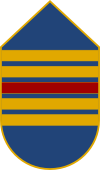Corps of the Gentlemen-at-Cudgels: Difference between revisions
Continuator (talk | contribs) m (→Structure) |
Continuator (talk | contribs) m (→Grades & ranks) |
||
| Line 41: | Line 41: | ||
|'''Bludgeoner-General'''|| [[file:CGC Grade 3.png|100px]]||Bludgeoner-General||OF-7||In overall command of the entire corps | |'''Bludgeoner-General'''|| [[file:CGC Grade 3.png|100px]]||Bludgeoner-General||OF-7||In overall command of the entire corps | ||
|- | |- | ||
|rowspan=3|'''Superintendants'''|| rowspan=3|[[file:N&H Grade 2.1.png|100px]]||Deputy Bludgeoner-General|| | |rowspan=3|'''Superintendants'''|| rowspan=3|[[file:N&H Grade 2.1.png|100px]]||Deputy Bludgeoner-General||OF-6||Reporting to the Bludgeoner-General, responsible for the discipline of all cudgellers within a given realm | ||
|- | |- | ||
|Quartermaster of Cudgels||OF-5||In charge of all logistical and administrative aspects of the wider corps | |Quartermaster of Cudgels||OF-5||In charge of all logistical and administrative aspects of the wider corps | ||
Revision as of 17:37, 10 August 2022

|
This article or section is a work in progress. The information below may be incomplete, outdated, or subject to change. |
The Corps of the Gentlemen-at-Cudgels was revived in 1707 AN as a paramilitary formation charged with law enforcement and internal security within the Benacian Union.
Organisation
Structure
Every bailiwick should have a minimum of a regiment (1,200 men) of cudgellers under the authority of a commander of cudgels, from whence derives the term "commandery" for the formation, with responsibility for day to day law enforcement, subject to the discipline, supervision, and oversight of superintendent officers placed over it at the governorate and realm levels. The actual strength of a commandery can vary from bailiwick to bailiwick, depending on local circumstances. In the larger metropolitan areas such as Ardashirshahr, Chryse, and Merensk, an allocation of multiple commanderies, distributed on a territorial basis determined by population density, may be require. Conversely, in the more sparsely populated boreal regions the commandery may a minimal establishment of barely a squadron (120 cudgellers) or a troop (40 cudgellers).
Enlistment, education & training
Enlistment requirements for the Corps of the Gentlemen-at-Cudgels were set in 1707 AN as follows:
- To have served eight years in the Benacian Union Defence Force, or its predecessors the Black Legions and the Union Defence Force, and to have attained the minimum rank of Usczosoþ Streïak (OR-4) prior to honourable discharge from service;
- To be between the ages of thirty and forty-five at the time of enlistment;
- To be bodily intact, without physical imperfections, limbs missing, or bio-mechanical augmentation, including prosthetics of any kind;
- To be taller than a riq;
- To be a have been member of the Nationalist & Humanist Party of good standing for at least four years at the time of enlistment;
- To be bound and sworn to the Union Covenant, with the name recorded upon the rolls of the covenanted in the year of enlistment;
- To have an unblemished record without criminal convictions or moral lapses unsanctioned by authority, and to be affirmed in this by the censor;
- To have been assessed as physically fit for duty, having undergone a medical examination by qualified physicians and having completed a ten kilometre run whilst carrying one req (60.4 kg) within 80 minutes.
Command & staff
Establishment
Manpower
Equipment
Grades & ranks
Uniform
The service uniform of the Gentlemen-at-Cudgels is a variant of the Pattern M1702 Service Uniform worn by the BUDF, albeit done in Ziegeish cotton and dyed blue-grey.
Pay & rations
With an enlistment bounty of six marks, the subsequent pay for officers and gentlemen of the corps was set in 1707 AN at two-thirds of the statutory amount due to personnel of equivalent rank in the BUDF. This was to be drawn monthly from paymasters designated to the task by the Civil Executive of Realm in which they were resident.
Ration entitlements were to be drawn directly from the hall of allocation and appropriation in the bailiwick where the cudgeller was garrisoned. Consistent with the Welfare laws of the Benacian Union, cudgellers were entitled to receive, in addition to the weekly Basic Ration, the Government & Guild Service Ration: bread (800g), eggs (1x), meat (230g), butter (50g), margarine (50g), edible oil, coffee, cheese (50g), sugar (225g), jam (60g). Officers were, of course, entitled to the additional daily set menu of the Higher Government & Guild Service Ration, available in their messes. The cold Field & Industrial Service Ration would be issued to cudgellers of all ranks daily on occasions when they were deployed away from their barracks for periods in excess of forty-eight hours.
After their first year of probationary service, at the rank of cudgel-carrier, the confirmed cudgeller is entitled to a further discretionary ration on the authority of the quartermaster of the corps.
| Day | Daily Entitlement |
|---|---|
| Amnure | 460 grams of biscuit, 420 grams of salted beef, 400 grams of pickled cabbage, onions, and peas, 5 litres of beer |
| Izillare | 460 grams of biscuit, 420 grams of salted pork, 400 grams of pickled cabbage, onions, and peas, 5 litres of beer |
| Reire | 460 grams of biscuit, 420 grams of bacon, 400 grams of pickled cabbage, onions, and peas, 5 litres of beer |
| Ermure | 460 grams of biscuit, 800 grams of salted fish, 200 grams of butter & cheese, 100 grams of chocolate, 4 litres of wine |
| Eljere | 460 grams of biscuit, 800 grams of salted fish, 200 grams of butter & cheese, 100 grams of chocolate, 4 litres of wine |
| Hyre | 460 grams of biscuit, 800 grams of salted fish, 200 grams of butter & cheese, 100 grams of chocolate, 4 litres of wine |
Amongst the liberties afforded to cudgellers of good standing was the privilege of being able to accumulate and trade their ration entitlements, either for resale or barter on the unregulated market or else to exchange unclaimed ration points for luxury entitlement points at an exchange rate of 5 to 1. Luxury entitlement points could in turn be redeemed at government commissary stores.




